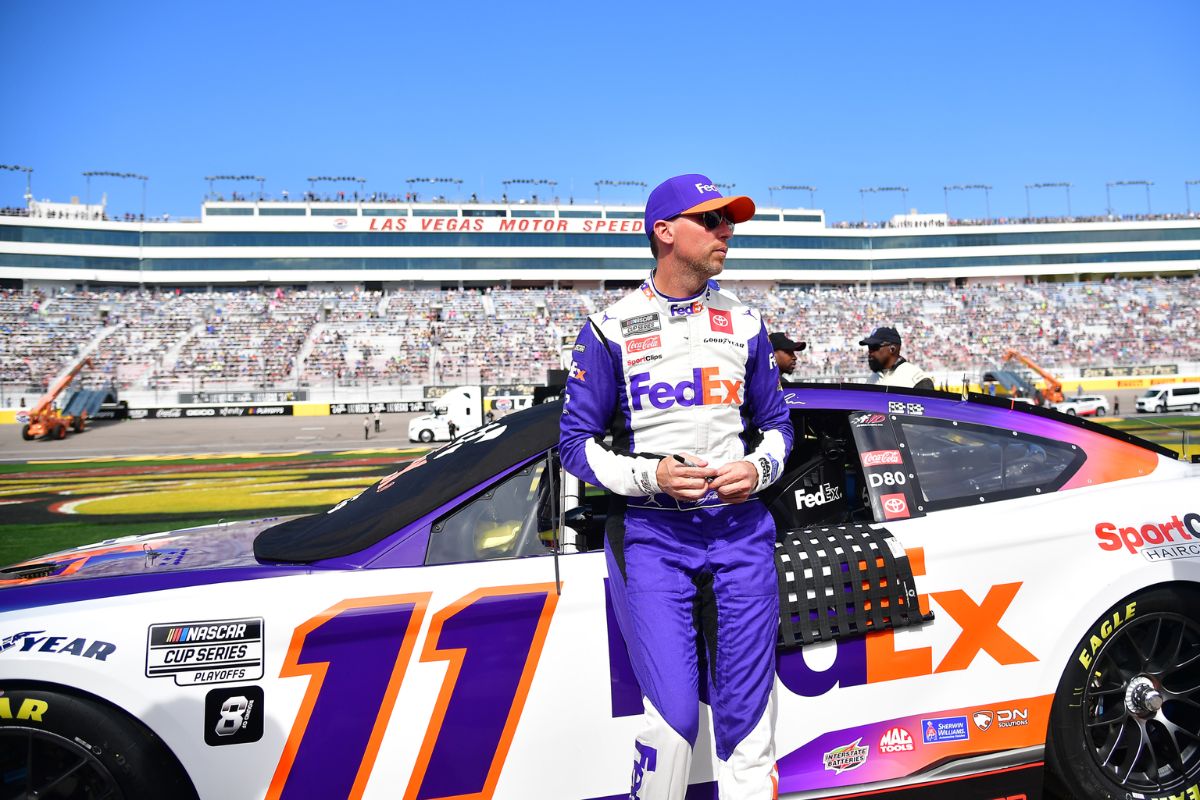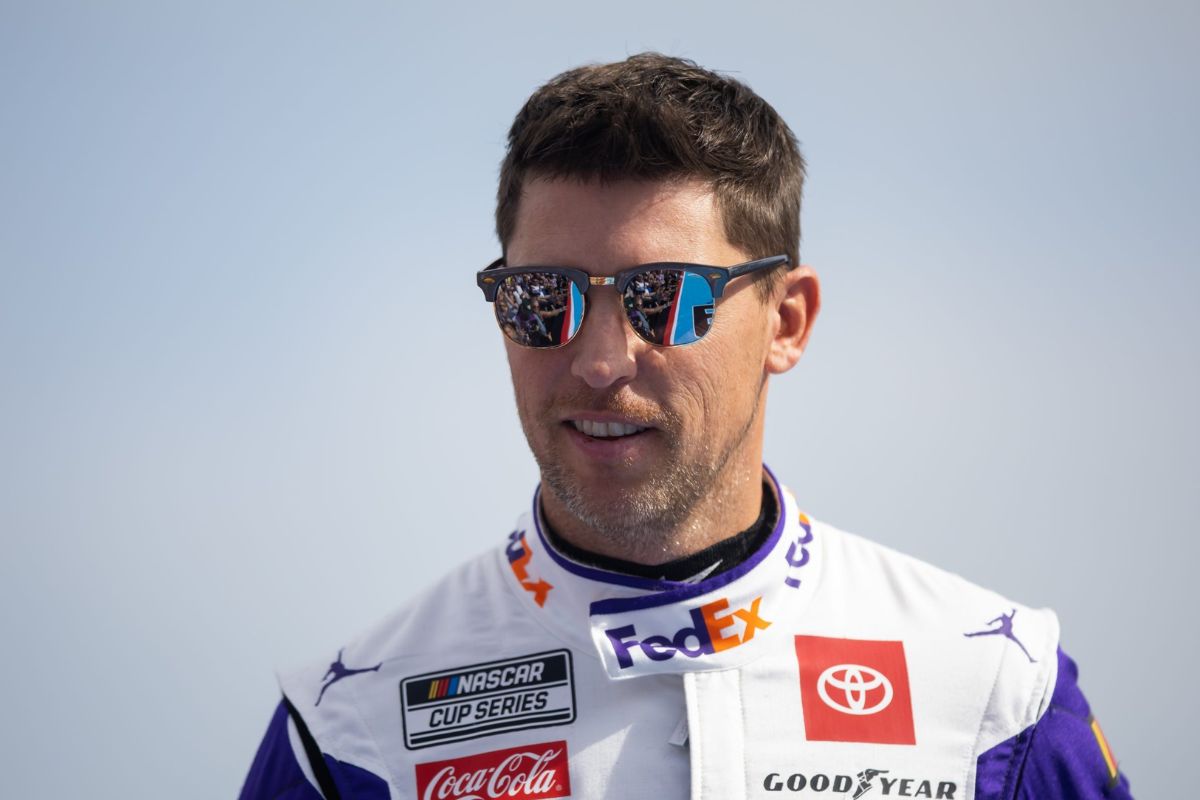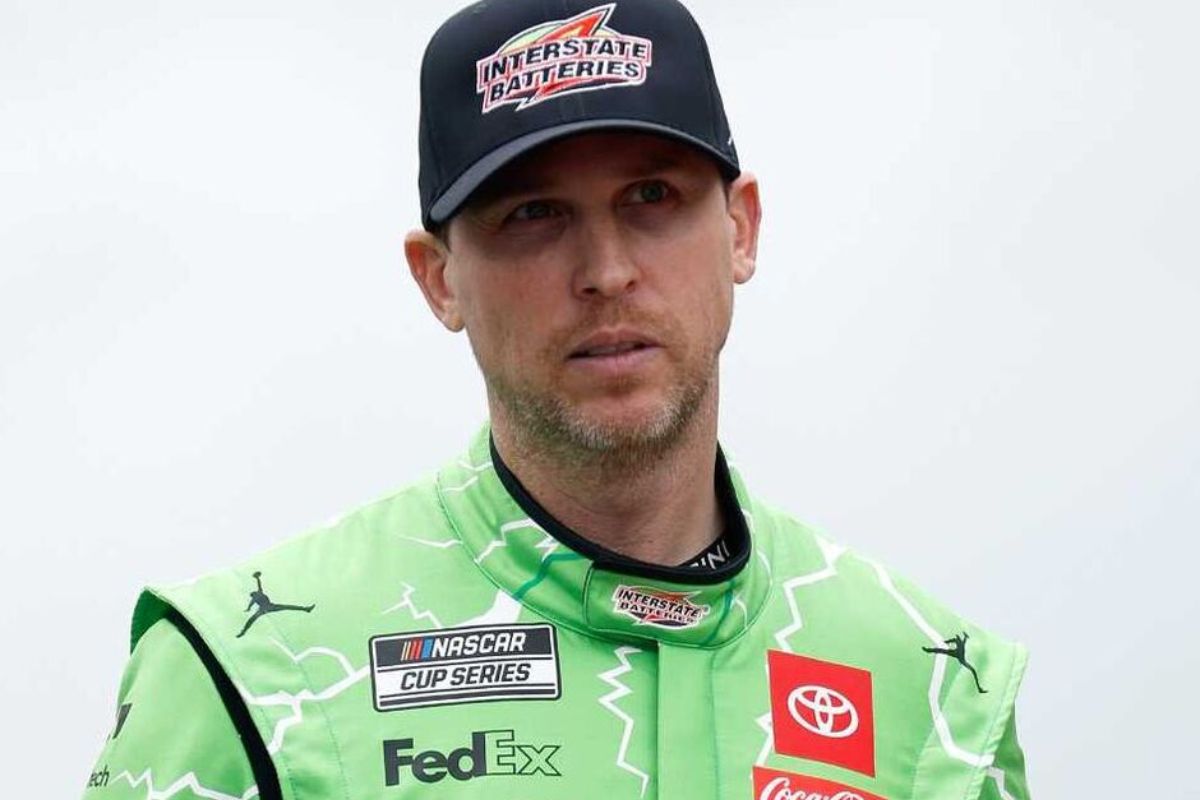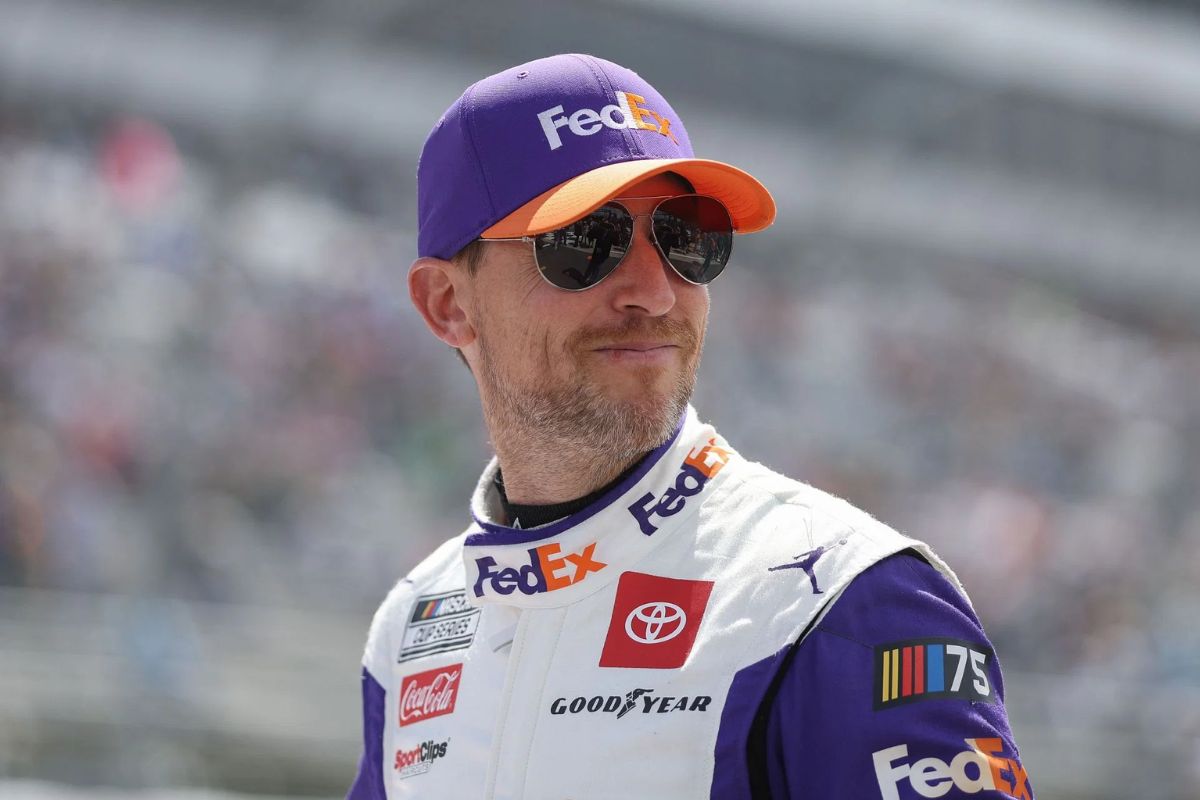Denny Hamlin’s Shocking Confession: In a recent disclosure that has sparked discussions in the NASCAR community, Denny Hamlin revealed his strategic efforts behind the scenes to enhance the sport’s appeal and sustainability. His admission not only highlights his dedication beyond mere competition but also emphasizes the delicate balance between personal achievement and the collective progress of NASCAR. This acknowledgment sheds light on the challenges and responsibilities top-tier athletes face in upholding the sport’s vibrancy and relevance in a constantly changing entertainment landscape.
Key Takeaways
- Denny Hamlin confessed his commitment to resolving broader NASCAR issues through his performance improvements.
- He is focused on mastering The Brickyard to set new standards in NASCAR.
- Hamlin’s use of advanced analytics and tire tests aims to enhance the overall racing conditions.
- His strategic approach and rigorous preparation are intended to foster a culture of continuous improvement in NASCAR.
- By addressing tire compound issues, Hamlin contributes to the safety and competitiveness of the sport.
Denny Hamlin’s Struggle at The Brickyard
Despite his substantial achievements in NASCAR, Denny Hamlin has consistently faced challenges at The Brickyard, a venue that has prominently highlighted his difficulties with road courses. Over the years, Hamlin’s performances at The Brickyard have contrasted with his otherwise stellar racing career. This track, with its unique demands and punishing layout, has exposed subtle deficiencies in Hamlin’s road racing techniques that aren’t apparent on oval circuits.
Analyzing Hamlin’s track record, it becomes evident that The Brickyard requires a distinct skill set, involving precision steering and braking, adept management of tire wear, and strategic fuel conservation. These elements are important on road courses where the race dynamics differ from oval tracks. Hamlin’s struggle at The Brickyard can be partly attributed to these factors, which require not just driving ability but also strategic insight and adaptability under varied track conditions.
Despite a solitary victory at Watkins Glen in 2016, which suggested a potential overcoming of his road course hurdles, consistent success has eluded Hamlin at The Brickyard. This indicates that while he may have the ability to conquer road courses occasionally, achieving regularity in such performances requires further refinement of his skills and strategies specific to road racing.
Hamlin’s Ambitious Goals After Dover Victory
Following his victory in Wurth 400 at Dover concrete oval track, Denny Hamlin has set ambitious goals for his next challenge at The Brickyard 400, aiming to capitalize on his recent momentum into overcoming past difficulties at this historic track. Historically, Hamlin’s experiences at the Indianapolis Motor Speedway (IMS) have been less than stellar. With the 2.5-mile speedway and the 2.439-mile road course presenting unique challenges, Hamlin’s previous performances have not displayed the expertise seen at other NASCAR venues. However, the recent success at Dover could mark a turning point for the seasoned racer.
Hamlin’s current focus is not just on leveraging his Dover victory, but also on transforming his track record at IMS. The proactive measures he has taken in preparation for The Brickyard 400 suggest a meticulous strategy aimed at mastering the complex dynamics of both the road course and the speedway. This indicates a broader view where each race is not just about the immediate win, but about continual growth and adaptation.
Moreover, the return of The Brickyard 400 after a three-year break adds complexity and opportunity. The event’s revival could serve as a symbolic fresh start for Hamlin, who is ready to redefine his legacy there.
Denny Hamlin’s Bold Prediction
Setting a new standard for himself and his team, Denny Hamlin’s recent declaration reflects a strong commitment to surpassing previous achievements in the NASCAR series. In an honest conversation on the podcast Actions Detrimental, Hamlin expressed dissatisfaction with the conventional satisfaction derived from three race wins, a number he has already achieved early in the season. This critical self-assessment marks a significant shift in Hamlin’s approach to racing, highlighting a relentless pursuit of excellence that goes beyond traditional benchmarks.
“See that’s not enough though. That’s not upto our standards as far as race wins in a season. So we’re probably just on schedule now when it comes to what we expect. Now we set some high expectations. Lots of guys take three wins and move on each year. But not us. Too high expectations.”-Hamlin
Hamlin’s bold prediction emerges from a backdrop of comparative analysis. By this point last season, he had not secured a single victory, indicating a notable improvement in performance and strategy this year. The comparison of his current success with the previous year’s struggles illustrates a path of rapid improvement and heightened ambition. This pattern of growth is not just a personal achievement but sets a new standard for his team and competitors in NASCAR.
“Probably twenty” two.”
“You said, how many ‘could’ the #11 win. Sure 22 is a lot. But it’s a real number. I mean I’m taking out the road courses, other than that. That’s all I’m taking out.” -hamlin
Hamlin’s Redemption Plan for The Brickyard
In a strategic pivot, Denny Hamlin has crafted a detailed redemption plan aimed at conquering The Brickyard, following his recent performance setbacks. This plan, deeply rooted in data analysis and aerodynamic optimization, is a response to the evolving competitive landscape in NASCAR, particularly the changes observed at Dover. With the advancements in car setups and aerodynamics discussed by Jordan Bianchi and Jeff Gluck, Hamlin’s approach is not merely reactive but anticipatory, positioning his #11 team for a robust performance in upcoming races.
Hamlin’s strategy involves a meticulous review of his car’s aerodynamic performance, especially focusing on tire wear and fuel efficiency, which are critical at The Brickyard’s rigorous 2.5-mile oval. By synthesizing data from previous races, both at The Brickyard and similar tracks, Hamlin and his team are recalibrating their vehicle setup to optimize speed while maintaining stability in the car’s handling.
Will have tire tests at Sonoma (repave), Iowa (new Cup track), Indy (somewhat new oval — also had one also last year) and tentatively Watkins Glen, Atlanta, Bristol. They typically do 7-10 a year. https://t.co/lL7baNZ2l2
— Bob Pockrass (@bobpockrass) March 19, 2024
Furthermore, Hamlin is investing in simulation drills that replicate The Brickyard’s unique conditions. These simulations are designed to refine his pit stop strategies and elevate his adaptability to real-time race variables.
Looking Ahead
As Denny Hamlin prepares for the upcoming Goodyear tire tests at IMS, the focus shifts to long-term strategic gains and solidifying his mastery of The Brickyard’s challenging conditions. This proactive approach highlights a commitment to precision and performance, essential for conquering the intricate details of such a legendary circuit.
“The brickyard I really want bad. We’re actually going to test there as well. The #11 car. That’s the one test we signed up for this year.”-Denny
The ongoing issues with tire compounds at The Brickyard have been a significant hurdle, and the forthcoming tests present a unique opportunity for Hamlin to engage directly with Goodyear’s engineers. By doing so, he positions himself at the forefront of technological advancements, potentially influencing tire formulations that align more closely with the demands of high-stakes NASCAR circuits. This hands-on involvement also enriches his understanding of the tire’s performance dynamics, an invaluable asset when maneuvering the high-speed corners and long straights of IMS.
News in Brief: Denny Hamlin’s Shocking Confession
Denny Hamlin’s acknowledgment of his influential role in promoting NASCAR highlights a substantial dedication to the sport’s advancement. His efforts on the track not only boost competition but also contribute greatly to NASCAR’s broader appeal and growth. Through his actions and foresight, Hamlin demonstrates leadership, fostering a positive trajectory for the sport and its community. This approach not only benefits current stakeholders but also secures a strong legacy for future generations within the racing domain.
Our Reader’s Queries
Q. Who is Denny Hamlin feuding with?
A. Marcus Smith, the chairman of Speedway Motorsports, a conglomerate overseeing 10 tracks on NASCAR’s Cup Series schedule, voiced disagreement with Hamlin’s post. Hamlin had highlighted the cancellation of a Thursday sports car test due to issues with the new surface on the California road course, prompting Smith to take exception.
Q. What happened to Denny Hamlin’s arm?
A. While engaged in a sporting event off the track, he suffered tendon tears. Subsequently, during the race at Homestead the following week, his car collided with the wall, exacerbating the situation. “Trying to race on it was just not good,” remarked Hamlin on the challenges posed by the injuries.
ALSO READ: Denny Hamlin Responds to Larson Amid Dover Disappointment




